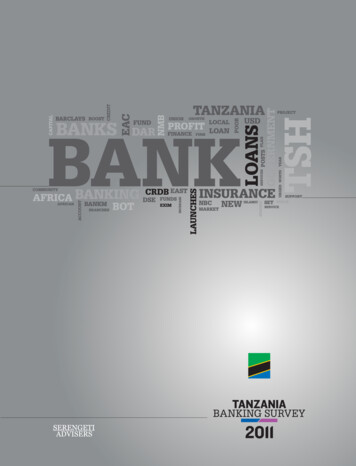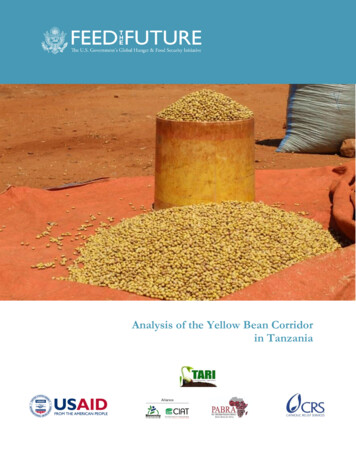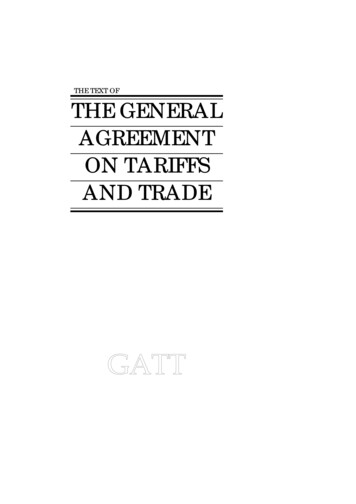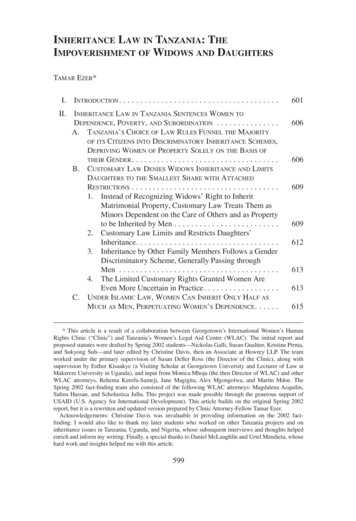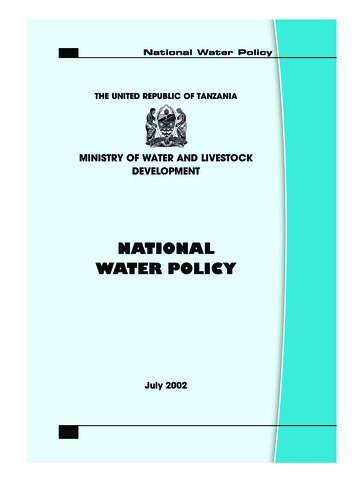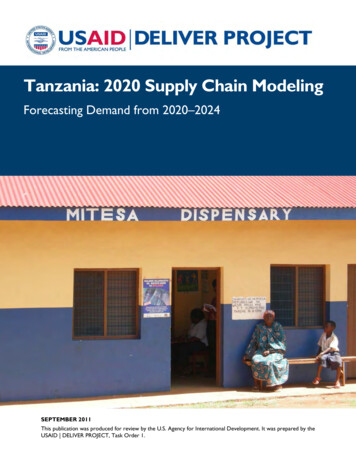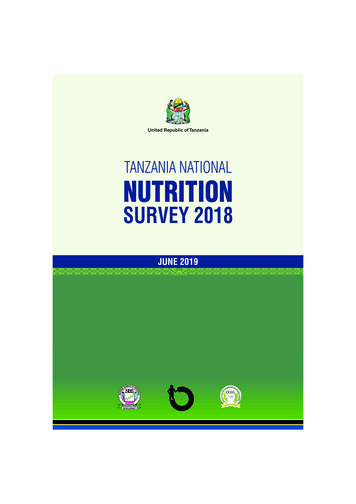
Transcription
The United Republic of TanzaniaMINISTRY OF FINANCE AND PLANNINGASSESSMENT OF THE PUBLIC FINANCE MANAGEMENTSYSTEMS OF THE CENTRAL GOVERNMENT APPLYINGTHE PEFA 2016 FRAMEWORKFINAL REPORTOCTOBER, 2017
TANZANIA MAINLANDPublic Expenditure & Financial Accountability (PEFA)Performance Assessment ReportBaseline AssessmentBased on PEFA 2016 FrameworkOctober 2017Final ReportAndrew Lawson, Finn Hedvall, Cecilie Thue-Hansen and Gonzalo Contreras****Tanzania Fiscal Year: 1st, July – 30th. JuneCurrency: Tanzanian Shilling (Tsh.)US 1 Tsh. 2,183 (April 2017)****
PEFA assessment of the PFM systems of the Tanzania Central Government2017PEFA Assessment Report of Tanzania– Final Report – September 29, 2017The quality assurance process followed in the production of this reportsatisfies all the requirements of the PEFA Secretariat and hence receivesthe ‘PEFA CHECK’.PEFA Secretariat,October 6, 2017Final Report; October 2017Page 3
PEFA assessment of the PFM systems of the Tanzania Central Government2017Table of ContentsAcronyms and Abbreviations . 7Executive Summary. 101. Introduction . 151.1 Rationale and Purpose . 151.2 Assessment management and quality assurance . 161.3 Assessment methodology . 172. Country Background Information . 192.1 Country economic situation . 202.2 Fiscal and budgetary trends . 222.3 Legal and regulatory arrangements for PFM . 252.4 Institutional arrangements for PFM . 282.5 Other important features of PFM and its operating environment . 313. Assessment of PFM Performance . 333.1 Overview . 333.2 Pillar I – Budget Reliability . 353.3 Pillar II – Transparency of Public Finances . 453.4 Pillar III – Management of assets & liabilities. 663.5 Pillar IV – Policy-based Fiscal Strategy and Budgeting . 843.6 Pillar V – Predictability and Control in Budget Execution . 983.7 Pillar VI – Accounting and Reporting . 1363.8 Pillar VII – External Scrutiny and Audit . 1464. Conclusions of the analysis of PFM systems . 1574.1 Integrated assessment of PFM performance . 1574.2 Key strengths and weaknesses of the Tanzania PFM system . 1654.3 Performance changes since last PEFA assessment . 1674.4 Effectiveness of the Internal Control Framework . 169Final Report; October 2017Page 4
PEFA assessment of the PFM systems of the Tanzania Central Government20175. The PFM Reform Process . 1755.1 Approach to PFM reforms . 1755.2 Recent and ongoing Reform Actions . 1765.3 Institutional considerations . 177Annex 1: Summary of 2017 Performance Assessment . 180Annex II: Performance changes 2013 – 2017 (applying 2011 PEFA Framework) . 190Annex III: Observations on the Internal Control Framework . 192Annex IV: Sources of Information . 194Annex V: Calculations for Budget Reliability Pillar (PI-1,2 & 3) . 210Table of Boxes, Figures and TablesBox 1–1: Assessment Management & Quality Assurance Arrangements . 16Box 2–1 Legal & regulatory arrangements for PFM in Tanzania . 26Box 5–1 Key objectives of the different phases of the Tanzania PFMRP . 175Table 0–1 Tanzania PFM system in 2017: Strengths, Weaknesses, Opportunities & Threats. 11Table 0–2: Summary of 2017 PEFA Scores for Tanzania Central Government . 14Table 2–1: Selected Economic Indicators 2012/13 - 2015/16 . 21Table 2–2: Tanzania Mainland Budget 2015/16 and 2016/7 . 22Table 2–3: Aggregate Fiscal Data 2012/13 - 2015/16 (in percent of GDP) . 23Table 2–4: Budgeted and Actual expenditures by function 2013/14 . 24Table 2–5: Budget expenditures by economic classification 2013/14 - 2015/16 . 25Table 2–6: Structure of the Public Sector (administrative classification 2014/15) . 29Table 2–7: Budget outturn 2014/15 according to the consolidated financial statement. . 30Table 3–1 Aggregate Budgeted Expenditure vs/ Actual Expenditure 2013/14 – 2015/16 . 36Table 3–2: Expenditure Composition by Administrative head, 2013/2014 . 38Table 3–3: Expenditure Composition by Administrative head, 2014/2015 . 38Table 3–4: Expenditure Composition by Administrative head, 2015/2016 . 39Final Report; October 2017Page 5
PEFA assessment of the PFM systems of the Tanzania Central Government2017Table 3–5: Variance from Budget in the expenditure composition outturn by institution . 39Table 3–6: Expenditure Composition by economic classification, 2013/2014. . 40Table 3–7: Expenditure Composition by economic classification, 2014/2015. . 41Table 3–8: Expenditure Composition by economic classification, 2015/2016. . 41Table 3–9: Collection of revenue compared with the original approved budget (Tsh. Millions). 44Table 3–10: Collection rates for different revenue categories 2013/14–2015/16 (Tsh m) . 45Table 3–11: PI-5: Assessment of 2016/17 Budget documentation . 49Table 3–12: PI-5: Assessment of Public Access to Fiscal Information. 64Table 3–13: PI-19: Domestic revenue collections by type & source, 2015/16 . 100Table 3–14: PI-19: Domestic revenue collections relative to targets, 2010/11 - 2015/16 . 104Table 3–15: Stock of arrears - Central Government of Tanzania. (Tsh. Billions) . 113Table 3–16: PI-24 Public Access to Procurement information . 124Table 3–17: PI-24 Assessment of Procurement complaints mechanism . 125Table 3–18: PI-29 Assessment of Consolidated Financial Statement 2014/15 . 144Table 3–19: PI-31 Timing of Audit report scrutiny by the PAC . 154Table 4–1: 2017 PEFA Assessment of Tanzania Mainland - Summary of PEFA scores by Pillar(2016 Framework) . 157Table 4–2: 2017 PEFA Assessment: Where is Tanzania achieving good practice?. 158Table 4–3: 2017 PEFA Assessment: Where do Tanzania’s systems need improvement? . 158Table 4–4 Summary of Changes recorded between 2013 and 2017 PEFA assessments . 167Table 4–5: Areas of recorded Improvement and Deterioration in PFM Performance 2013 2017 (according to 2011 PEFA Framework) . 168Table 4–6 Summary of implications of the 2017 PEFA assessment for the Internal ControlFramework . 173Figure 2-1: Map of the United Republic of Tanzania (URT) . 20Figure 3-1: Age profile of arrears 2012 – 2014 - Central Government (Tsh. Billions) . 113Figure 3-2: Composition of expenditure arrears at end of June 2014 . 114Final Report; October 2017Page 6
PEFA assessment of the PFM systems of the Tanzania Central Government2017Acronyms and AbbreviationsACGENAccountant GeneralAfDBAfrican Development BankAFROSAI-EAPERBCGAfrican branch of the International Organisation of Supreme AuditInstitutions, English language subgroupAnnual Performance Evaluation Reports (for Procurement)Budgetary Central GovernmentBoTBank of TanzaniaCAGController & Auditor GeneralCBACost Benefit AnalysisCGCentral GovernmentCS-DRMSCommonwealth Secretariat Debt Recording & Management SystemCFConsolidated FundCOFOGClassification of the Functions of GovernmentCPOCentral Payments OfficeDARTDar es Salaam Rapid Transit (bus system)DFIDUK Department for International DevelopmentDSADebt Sustainability AnalysisECAExport Credit AgencyEFDElectronic Fiscal DeviceEINExchequer Issue NotificationEWURAEnergy & Water Utilities Regulatory AuthorityFYFiscal YearFYDP (II)(Second) Five Year Development PlanGAMDGovernment Asset Management DivisionGBDGovernment Budget Division (of MoFP)GDPGross Domestic ProductGFSMGovernment Finance Statistics Manual (of the IMF)GLGGAGovernment Loans Guarantees & Grants nAgencyforInternational Cooperation)GoTGovernment of TanzaniaHCMISHuman Capital Management Information System (Lawson system)HROHuman Resource OfficerIAInternal AuditIAG(D)Internal Auditor General’s DepartmentICBInternational Competitive BiddingIDIINTOSAI Development InstituteIFMISIntegrated Financial Management System (Epicor system)Final Report; October 2017Page 7
PEFA assessment of the PFM systems of the Tanzania Central Government2017IIAInstitute of Internal AuditorsIMFInternational Monetary FundIMTCInter-Ministerial Technical Committee (of Permanent Secretaries)INTOSAIInternational Organisation of Supreme Audit InstitutionsIPPFInternational Professional Practices Framework (of the IIA)IPSASInternational Public Sector Accounting StandardsISSAIInternational Standards of Supreme Audit InstitutionsJICAJapan International Cooperation AgencyJPIMCJoint Public Investment Management CommitteeLGALocal Government AuthorityLGDGLocal Government Development GrantLPOLocal Purchase OrderLTDLarge Taxpayers’ DepartmentMDAsMinistries, Departments & Agencies (of Central Government)MESTVTMinistry of Education, Science, Technology & Vocational TrainingMKUKUTAMoFPMpango wa Kukuza Uchumi na Kupunguza Umasikini Tanzania (TanzaniaNational Strategy for Growth & Poverty Reduction)Ministry of Finance & PlanningMTDSMedium Term Debt StrategyMTEFMedium Term Expenditure FrameworkMTSPBMMedium Term Strategic Planning & Budget ManualMWTCMinistry of Works, Transport & CommunicationsNAOTNational Audit Office of TanzaniaNBSNational Bureau of StatisticsNCBNational Competitive BiddingNDFNet Domestic FinancingOCOther ChargesOECDOrganisation for Economic Cooperation and DevelopmentOTROffice of the Treasury RegistrarPAAPublic Audit ActPAC(Parliamentary) Public Accounts CommitteePADPolicy Analysis Division (of MoFP)PA&OBPublic Authorities & Other BodiesPBBProgramme Based BudgetingPBGPlan & Budget GuidelinesPEPersonnel EmolumentsPEFAPublic Expenditure & Financial AccountabilityPERPublic Expenditure ReviewPFMPublic Finance ManagementFinal Report; October 2017Page 8
PEFA assessment of the PFM systems of the Tanzania Central Government2017PFMRPPublic Finance Management Reform ProgrammePGPaymaster GeneralPIPerformance Indicator (of the PEFA framework)PIMPublic Investment ManagementPIM-OMPublic Investment Management-Operational ManualPMISProcurement Management Information SystemPO-PSMPresident’s Office – Public Service ManagementPO-RALGPresident’s Office – Regional Administration & Local GovernmentPPAAPublic Procurement Appeals AuthorityPPPPublic Private PartnershipsPPRAPublic Procurement Regulatory AuthorityPSPermanent SecretaryPSPFPublic Services Pension FundQAQuality AssuranceRASRegional Administrative SecretariatRTAC(IMF) Regional Technical Assistance CentreSAISupreme Audit InstitutionSAI-PMFSupreme Audit Institutions’ Performance Measurement FrameworkSSRASocial Security Regulatory AuthorityTADATTax Administration Diagnostic Assessment ToolTANESCOTanzania Electricity Supply CompanyTCCIATanzania Chamber of Commerce, Industry & AgricultureTRATanzania Revenue AuthorityTRIMSTreasury Registrar Information Management SystemURTUnited Republic of TanzaniaUSAIDUnited States Agency for International DevelopmentVATValue Added TaxWBWorld BankFinal Report; October 2017Page 9
PEFA assessment of the PFM systems of the Tanzania Central Government2017Executive SummaryThis Report presents an independent assessment of the status of public financial management(PFM) in Mainland Tanzania and an assessment of progress in the implementation of PFMreforms. It is based on the application of the PEFA methodology, as updated in 2016. In addition, the 2011PEFA methodology has been applied so as to permit comparison with the three previous assessmentsconducted at the national level (2006, 2009 and 2013). Its purpose has been threefold:(i) To assist the Government in prioritising the implementation of PFM reforms and systemsenhancements;(ii)To inform the dialogue on PFM between Government and its Development Partners;(iii) To provide an input into how the next phase of PFMRP should be designed, implemented andmonitored.The fifth phase of the PFM reform programme (PFMRP V, 2017 – 2022) was launched in July 2017, the startof fiscal year 2017/18. The design process has taken place in parallel with the implementation of the PEFAassessment and it has drawn closely on the findings of this Report.The Government of Tanzania (GoT) has led the 2017 PEFA assessment through thePermanent Secretary of the Ministry of Finance & Planning (MoFP), with financial support fromDenmark. The Government appointed a Management & Oversight team to oversee the assessment, as wellas a Task Force Secretariat to provide managerial and logistical support. The assessment has beenundertaken by Fiscus – a UK based public finance consultancy company, working in conjunction with staff ofSIPU International, Sweden and of IDI, the INTOSAI Development Institute based in Oslo.The assessment covers the Central Government of Mainland Tanzania, which is comprised of approximately50 ministries, departments and commissions, 26 Regional Administrative Secretariats and 183 autonomousor semi-autonomous agencies (extra-budgetary units). The assessment covers neither the 180 LocalGovernment Associations (LGAs) and their related water corporations, which comprise a lower tier ofGovernment, nor the 7 Social Security Funds and 41 Public Corporations, which comprise part of GeneralGovernment and the Public Sector respectively, but not part of Central Government.The assessment is based upon information from the three most recent completed financialyears (2013/14, 2014/15 & 2015/16), and, where relevant, on information on the process of theformulation and execution of the 2016/17 Budget. Field work was undertaken in March 2017 and theanalysis in this report is based on data and reports available up to 14th, July 2017, the agreed deadline forreceipt of comments following the presentation of the key findings in Dar es Salaam on 4th, July 2017.Table 0-1 presents an overview of the strengths, weaknesses, opportunities and threats identified throughthe 2017 assessment of the PFM system. A summary presentation of the scores against the 31 indicators ofthe 2016 PEFA Framework is presented in Table 0-2.Final Report; October 2017P a g e 10
PEFA assessment of the PFM systems of the Tanzania Central Government2017Table 0–1 Tanzania PFM system in 2017: Strengths, Weaknesses, Opportunities & ThreatsStrengthsWeaknessesPI-6: Reporting on Central Government§PI-2 & 3: Budget Credibility indicatorsextra-budgetary operations§PI-5: Budget Documentation;§PI-10: Fiscal Risk reporting§PI-9: Public Access to Fiscal Information§PI-12: Public Asset Management§PI-11: Public Investment Management§PI-13: Debt Management§PI-15: Fiscal Strategy;§PI-17: Budget preparation process;§PI-16:§PI-18: Legislative Scrutiny of Budgets§PI-20: Accounting for Revenue;§PI-23: Payroll rspectiveinexpenditure budgeting§PI-21: Predictability of In-Year ResourceAllocation;ofAuditreports§PI-22: Expenditure Arrears;§PI-25: Internal controls on Non-salaryspendingEmerging strengths/ areas improving:§§§PI-24 Procurement ManagementPI-26 Internal AuditPI-30 External Audit§PI-28: In-Year Budget ReportsAreas where reform progress is slowing:§PI-19 Revenue AdministrationOpportunitiesüüüüGood potential for further improvement inareas of strength to reach international bestpractice standardsPotential for “quick wins” on Budgetdocumentation, Public access to Fiscalinformation, Fiscal strategy and In-Year BudgetReports through careful attention to the formatof reports & their timely publication.Public Investment Management OperationalManual (PIM-OM) and the related structuresand procedures offer sound basis forstrengthening investment management.Scope for re-thinking the approach to the MTEFand to Programme Based Budgeting so as tosimplify formats and procedures and focus on anarrow set of objectives, where a re-designedMTEF/ PBB can have most effect.ThreatsØØØØContinued discrepancies between Budgets andActual Expenditures have undermined credibilityof the Budget, reinforcing bad budgetingpractices and a lack of confidence in the systemat MDA level.An approach to cash management based on cashrationing rather than cash planning hasundermined the system of commitmentcontrols, resulting in expenditure arrears andunpredictable budgets.This in turn has undermined the ability of thePFM system to promote the allocation ofresources in line with strategic priorities and tofacilitate efficient service delivery.Consistent historical improvements in revenueadministration are slowing, at a time whenTanzania is becoming increasingly reliant ondomestic revenue mobilisation.The overall picture emerging from the 2017 PEFA assessment is broadly positive: there areseveral important areas of strength and quite a number of the weaknesses identified could beaddressed without too much difficulty in the short-term. A reading of the strengths, weaknessesand opportunities identified in Table 0-1 confirms this picture.Final Report; October 2017P a g e 11
PEFA assessment of the PFM systems of the Tanzania Central Government2017Government has a strong set of procedures by which to monitor and control the majorpotential threats to aggregate fiscal discipline, based upon the processes relating to debtmanagement, the reporting of Central Government extra-budgetary operations, and the monitoring of fiscalrisk from the wider public sector. Legislative scrutiny of the Budget and of External Audit reports workwell and improvements are being recorded in Internal and External Audit and in most aspects of accountingand financial reporting, as the Government progresses towards the implementation of IPSAS accrualstandards. Payroll controls have been tightened in recent years and improvements have also been recordedin procurement management. These systems provide the basic ‘nuts and bolts’ for efficient service delivery.Several of the weaknesses identified in the 2017 assessment could be corrected relativelystraightforwardly by dedicating attention to the specific shortcomings identified in this report.In particular, careful attention to the format of public reports and to their timely publication could generate‘quick wins’ in relation to Budget documentation, Public access to Fiscal information, Fiscal strategy and InYear Budget Reports. Strengthening Public Investment Management will be a longer term process, withextensive investment in capacity development and consolidation of systems still required but the PublicInvestment Management Operational Manual (PIM-OM) and the related structures and procedures recentlyintroduced offer a sound basis for strengthening investment management.Strengthening of medium term expenditure budgeting will also be a medium to long termprocess but the Government has displayed a willingness to review the current, overly complexapproach that has been adopted to the implementation of the MTEF. The peculiarly detailedformat that has been chosen for the formulation of medium term projections on the basis of activity-basedcostings generates a heavy burden of work for MDAs and, in addition, complicates the process of adaptingMTEF projections during the budget scrutiny process, with the result that this is not done effectively. Areview of the approach to the MTEF would be very timely, with the basic objective of developing aframework for medium term budgeting that is simple and fit for purpose, starting from a carefulreassessment of what are the core objectives of such a system in Tanzania. However, a precondition for aneffective medium term budget is a credible annual budget, which is not currently the case.The lack of a reliable, credible annual budget is perhaps the biggest threat to the TanzaniaPFM system. The continuing weaknesses in core aspects of PFM – budget credibility, cash management,commitment control – threaten to undermine the value of the improvements achieved in other areas. Highlevels of expenditure arrears and weaknesses in the monitoring of arrears have been persistent problemsin Tanzania, reported in both the 2010 and 2013 PEFA assessments. However, the 2017 assessment pointsto a further deterioration, with the stock of arrears now hovering at around 10% of total expenditure.The primary obstacle to prudent monitoring of arrears and accounts payable is the cashrationing system and the way EPICOR is set up to restrict payments, as the system rejects anyexpenditure entries – including entries for commitments - that go above the monthly payment ceilings, orbeyond the current month. As a result, the commitment function in EPICOR is rendered effectively uselessFinal Report; October 2017P a g e 12
PEFA assessment of the PFM systems of the Tanzania Central Government2017because it is only possible to make commitments for payments which will be paid in the same month andwhich fall within the available payment ceiling.The cash rationing system has created a situation where the budget is not credible and arrearsbuild up: aggregate fiscal discipline is maintained but the strategic allocation of resources isundermined and service delivery suffers. With an improved economic situation, coupled to afunctioning financial management system, the time is ripe for substantial improvements, focused on moremodern, and more flexible systems of cash planning and commitment control, which support thepredictability of the budget, while controlling the fiscal deficit.A less obvious, longer-term threat to the performance of the PFM system is presented by theapparent slow-down in the process of strengthening revenue administration. In the last tenyears, there have been steady and consistent improvements in revenue administration but the 2017 PEFAassessment shows a deterioration relative to 2013, applying the 2011 methodology. Moreover, the scoreagainst the 2016 framework was no higher than a “C ”, which suggests that the system is falling short ofthe high standards required of a modern, efficient tax administration. The more detailed TADAT assessmentconducted in 2016 gives strong evidence in support of this view: it revealed a variety of weaknesses, mostnotably in relation to the reliability of the taxpayer registration database and the IT system for taxadministration. Ongoing reforms are being pursued which should help to accelerate improvements in therevenue administration system: these will be especially important to implement rigorously and effectively,as the Tanzania economy grows and access to grant aid and concessional finance is reduced.A comparison of the scores of the 2013 and 2017 PEFA assessments following the same methodology - the2011 PEFA Framework – is complicated by the fact that the evidence base in 2017 is a good deal strongerthan it was in 2013. With the benefit of hindsight and additional information, it is clear that a number of theratings assigned in 2013 were too high. There is no procedure to make a formal correction of past PEFAreports. However, if one were to take into account the two very clear cases of “over-scoring” in the 2013assessment, the aggregate comparison between the two periods would read: improvement in 9 indicators,deterioration in 8 indicators and no change in 11 indicators. Overall then, the comparison points toa modest aggregate improvement in PEFA scores over the period.Notwithstanding this overall judgement that PFM performance is improving, it is instructive to examine theareas where deterioration is identified by application of the 2011 framework. These directly highlight thesame threats to PFM performance, which we have identified above: the core processes of budgeting, cashmanagement and commitment control have deteriorated, as also has revenue administration.PFMRP V provides a strong basis for addressing these threats but it will be essential to ensurethe scope and direction of reforms is sufficient to correct the weaknesses identified. Only ifthese threats are properly tackled can Tanzania strengthen the ability of the PFM system not only to ensureaggregate fiscal discipline but also to allocate resources in line with strategic priorities and to promoteefficient service delivery.Final Report; October 2017P a g e 13
PEFA assessment of the PFM systems of the Tanzania Central Government2017Table 0–2: Summary of 2017 PEFA Scores for Tanzania Central GovernmentPFM Performance Indicator(2016 PEFA Framework)Dimension RatingsScoringMethodi.PI-1Pillar I. Budget reliabilityAggregate expenditure outturnM1CPI-2PI-3Expenditure composition outturnRevenue outturnM1M2DDii.iii.iv.OverallRatingCCCAD D II. Transparency of public financesPI-4PI-5PI-6Budget classificationBudget documentationCG operations outside financial reportsM1M1M2CDBCPI-7Transfers to subnational GovernmentsM2DAPI-8Performance information for service deliveryM2BCPI-9M1DPI-10Public access to fiscal informationIII. Management of assets and liabilitiesFiscal risk reporting.M2DABPI-11Public investment managementM2CCDPI-12Public asset managementM2BCBBPI-13Debt managementIV. Policy-based fiscal strategy and budgetingM2BBCBPI-14Macroeconomic and fiscal forecastingM2ACDC PI-15M2DCCD M2DDCM2M1ABAAPI-19Fiscal strategyMedium-term Perspective in ExpenditureBudgetBudget preparation processLegislative scrutiny of budgetsV. Predictability and control in budget executionRevenue administrationM2CPI-20Accounting for revenueM1PI-21Predictability of in-year resource allocationPI-22PI-23PI-24PI-16CDBBC DCCDBDD DDBBAAB CCBC ABAM2DCDCD Expenditure arrearsM1DDPayroll controlsProcurement managementM1M2ADADBCBAB CPI-25Internal controls on non-salary expenditureM2BCDPI-26M1BCCCC PI-27Internal auditVI. Accounting and reportingFinancial data integrityM2BDDBCPI-28In-year budget reportsM1DDDDPI-29M1CBCC PI-30Annual financial reportsVII. External scrutiny and auditExternal auditM1BBBCC PI-31Legislative scrutiny of audit reportsM2CABCBPI-17PI-18Final Report; October 2017B DCP a g e 14
PEFA assessment of the PFM systems of the Tanzania Central Government20171. Introduction1.1 Rationale and Purpose1.The purpose of this study is to present an independent assessment of the status of publicfinancial management (PFM) in Tanzania and an assessment of p
HCMIS Human Capital Management Information System (Lawson system) HRO Human Resource Officer IA Internal Audit . s Department ICB International Competitive Bidding IDI INTOSAI Development Institute IFMIS Integrated Financial Management System (Epicor system) PEFA assessment of the PFM systems of the Tanzania Central Government 2017 .


